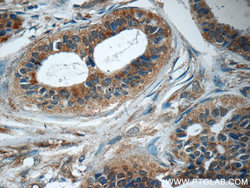Antibody data
- Antibody Data
- Antigen structure
- References [6]
- Comments [0]
- Validations
- Western blot [1]
- Immunohistochemistry [1]
Submit
Validation data
Reference
Comment
Report error
- Product number
- 25173-1-AP - Provider product page

- Provider
- Proteintech Group
- Product name
- SAMD9L antibody
- Antibody type
- Polyclonal
- Description
- KD/KO validated SAMD9L antibody (Cat. #25173-1-AP) is a rabbit polyclonal antibody that shows reactivity with human and has been validated for the following applications: IF, IHC, WB, ELISA.
- Reactivity
- Human
- Host
- Rabbit
- Conjugate
- Unconjugated
- Isotype
- IgG
- Vial size
- 20ul, 150ul
Submitted references Integrated Analysis Identifies Upregulated SAMD9L as a Potential Biomarker Correlating with the Severity of Primary Sjögren's Syndrome.
Shared biomarkers of multi-tissue origin for primary Sjogren's syndrome and their importance in immune microenvironment alterations.
Viral host range factors antagonize pathogenic SAMD9 and SAMD9L variants.
New spinocerebellar ataxia subtype caused by SAMD9L mutation triggering mitochondrial dysregulation (SCA49).
Clinical evolution, genetic landscape and trajectories of clonal hematopoiesis in SAMD9/SAMD9L syndromes.
A paralogous pair of mammalian host restriction factors form a critical host barrier against poxvirus infection.
Zhou D, Yu X, Yu K, Ren Y, Yang K, Wang X, Wang Q
Journal of inflammation research 2023;16:3725-3738
Journal of inflammation research 2023;16:3725-3738
Shared biomarkers of multi-tissue origin for primary Sjogren's syndrome and their importance in immune microenvironment alterations.
Cai T, Xu J, Fang Y, Wu Y, Qin Q, Zhang JA
Immunobiology 2023 Sep;228(5):152726
Immunobiology 2023 Sep;228(5):152726
Viral host range factors antagonize pathogenic SAMD9 and SAMD9L variants.
Gahr S, Perinetti Casoni G, Falk-Paulsen M, Maschkowitz G, Bryceson YT, Voss M
Experimental cell research 2023 Apr 15;425(2):113541
Experimental cell research 2023 Apr 15;425(2):113541
New spinocerebellar ataxia subtype caused by SAMD9L mutation triggering mitochondrial dysregulation (SCA49).
Corral-Juan M, Casquero P, Giraldo-Restrepo N, Laurie S, Martinez-Piñeiro A, Mateo-Montero RC, Ispierto L, Vilas D, Tolosa E, Volpini V, Alvarez-Ramo R, Sánchez I, Matilla-Dueñas A
Brain communications 2022;4(2):fcac030
Brain communications 2022;4(2):fcac030
Clinical evolution, genetic landscape and trajectories of clonal hematopoiesis in SAMD9/SAMD9L syndromes.
Sahoo SS, Pastor VB, Goodings C, Voss RK, Kozyra EJ, Szvetnik A, Noellke P, Dworzak M, Starý J, Locatelli F, Masetti R, Schmugge M, De Moerloose B, Catala A, Kállay K, Turkiewicz D, Hasle H, Buechner J, Jahnukainen K, Ussowicz M, Polychronopoulou S, Smith OP, Fabri O, Barzilai S, de Haas V, Baumann I, Schwarz-Furlan S, European Working Group of MDS in Children (EWOG-MDS), Niewisch MR, Sauer MG, Burkhardt B, Lang P, Bader P, Beier R, Müller I, Albert MH, Meisel R, Schulz A, Cario G, Panda PK, Wehrle J, Hirabayashi S, Derecka M, Durruthy-Durruthy R, Göhring G, Yoshimi-Noellke A, Ku M, Lebrecht D, Erlacher M, Flotho C, Strahm B, Niemeyer CM, Wlodarski MW
Nature medicine 2021 Oct;27(10):1806-1817
Nature medicine 2021 Oct;27(10):1806-1817
A paralogous pair of mammalian host restriction factors form a critical host barrier against poxvirus infection.
Meng X, Zhang F, Yan B, Si C, Honda H, Nagamachi A, Sun LZ, Xiang Y
PLoS pathogens 2018 Feb;14(2):e1006884
PLoS pathogens 2018 Feb;14(2):e1006884
No comments: Submit comment
Supportive validation
- Submitted by
- Proteintech Group (provider)
- Main image

- Experimental details
- COLO 320 cells were subjected to SDS PAGE followed by western blot with 25173-1-AP( SAMD9L Antibody) at dilution of 1:1000
- Sample type
- cell line
Supportive validation
- Submitted by
- Proteintech Group (provider)
- Main image

- Experimental details
- The SAMD9L antibody from Proteintech is a rabbit polyclonal antibody to a fusion protein of human SAMD9L. This antibody recognizes human antigen. The SAMD9L antibody has been validated for the following applications: ELISA, IHC, WB analysis.
 Explore
Explore Validate
Validate Learn
Learn Western blot
Western blot ELISA
ELISA